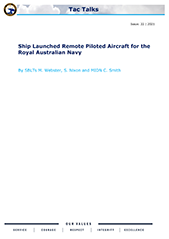Tac Talks: Ship Launched Remote Piloted Aircraft for the Royal Australian Navy

PDF : 699.87 KB
Introduction
Australia is a country where the tyranny of distance has a significant impact for defence planners. The Australian area of interest is vast, and the task of securing it difficult, especially with limited assets. The role of the RAN in the protection of our interests is paramount, but exhaustive. RAN ships are required to travel vast distances not only within our littoral waters, but also within those of our Asian and Pacific neighbours.
Ships are often operating in areas without air support from the RAAF or NAS Nowra. Consequently, much of their AAW and OTHT training is limited to scheduled periods in the locality of air assets. This paper will discuss the advantages and application of Ship Launched Remote Piloted Aircraft, (SLRPA) with special regard to the operational commitment and deployment of the RAN.
Ship Launched Remote Piloted Aircraft (SLRPA)
Although the concept of a remote piloted aircraft is not new, its ability of launching from a ship at sea is only now being realised. The United States Navy is using a propeller driven, video and link capable aircraft (UAV-SR) for Naval Gunfire Support spotting in the Persian Gulf. Launched from the quarterdeck via a catapult, it is capable of sustaining flight for sixty to ninety minutes. The SLRPA is retrieved by flying into a recovery net rigged on the ships quarterdeck, or by a controlled ditching into the ocean for an alongside recovery.
Multi-tasked Employment
The current experimental model SLRPA used by the US Navy on its Iowa class battleships may be too large for use on the smaller ships of the RAN, thus the option of buying an ‘off the shelf’ US design may not be practicable. For this vehicle to be successfully used by the RAN, certain modifications or an entirely new aircraft may need to be designed. The basic SLRPA would need to have satellite navigation (GPS) and a video/data link capability. In order to fulfil the multi-functional role, of the SLRPA, the parent ship would be required to carry a variety of additional components. These inter-changeable components could include a radar reflector, ESM/ECM equipment and an infrared detection unit. ‘Snap on-snap off’ components would allow the SLRPA to conduct a variety of tasks while restricting its structure to a manageable and realistic size for employment on RAN ships.
SLRPA can be effectively be employed in positively identifying distant targets for command appreciation. With the use of a real-time video link, the SLRPA is capable of positively locating and identifying targets, critically important during periods when surveillance aircraft are not available and Emcon restrictions prohibit the use of shipborne sensors. This capability can also be adapted to Naval Gunfire Support target indication using laser designation, as the US Navy has demonstrated in the selective bombardment of Kuwait.
The tactical employment of such a vehicle should not be restricted to OTHT. Its versatility is one of the SLRPAs biggest assets. Additionally, the SLRP can be employed in reconnaissance, classification of targets.
Financial benefits
With increasing restraints on the defence budget, the RAN must look at alternative ways of training that are effective, realistic but also cost efficient. The SLRPA, possibly costly at the development stage, should be economically viable in the long term. In its role as a training aid in tracking serials and gunnery firings, it would relieve some of the need to use costly air assets such as Learjets, F-llls and F/A18s.
Training
The SLRPA offers numerous training advantages. It provides the opportunity for ships to conduct realistic tracking and gunnery serials in areas where aircraft and missile simulation targets are unavailable, and would afford more flexibility in programming. The SLRPA could also be designed to simulate a variety of targets with both active and passive augmentation. This simulation would allow the incoming SLRPA to take on the characteristics of a variety of threats in both electronic signature and video size, adding to the realism of the exercise.
Emerging capability
With Australia’s commitment to maintaining a presence in South East Asia, the Southwest Pacific and in patrolling its vast exclusive economic zone, the constant availability of a SLRPA to conduct such operations would be a new and most beneficial asset. The SLRPA could also be modified for fisheries surveillance in the waters of Northern Australia, and could possibly be suitable to support NORFORCE operations.
Conclusion
This paper has endeavoured to conceptualise the vast potential of a ship launched remote piloted aircraft within the current operational framework of the RAN. The SLRPA will reduce the requirement for ships to transmit on shipborne radars when encountering the enemy, thus maintaining an element of surprise whilst simultaneously receiving real-time tactical information during day or night operations. The vast capabilities of such a small relatively simple and inexpensive vehicle have only recently been realised by the US Navy, and should be actively explored by the RAN.
Bibliography
- Drone Teams to Fly-off In March, Jane’s Defence Weekly, 27 Oct 90, p804.
- Cook, N, Army Bears Brunt of Defence Cuts, Jane’s Defence Weekly, 10 Nov 90, p 925.
- Starr, B, USA Examines 22 Foreign System, Jane’s Defence Weekly, 8 Dec 90, p1143.
- Positive Target Identification in Over The Horizon Targeting, TACTALKS edition No 12, pp 55-56.




